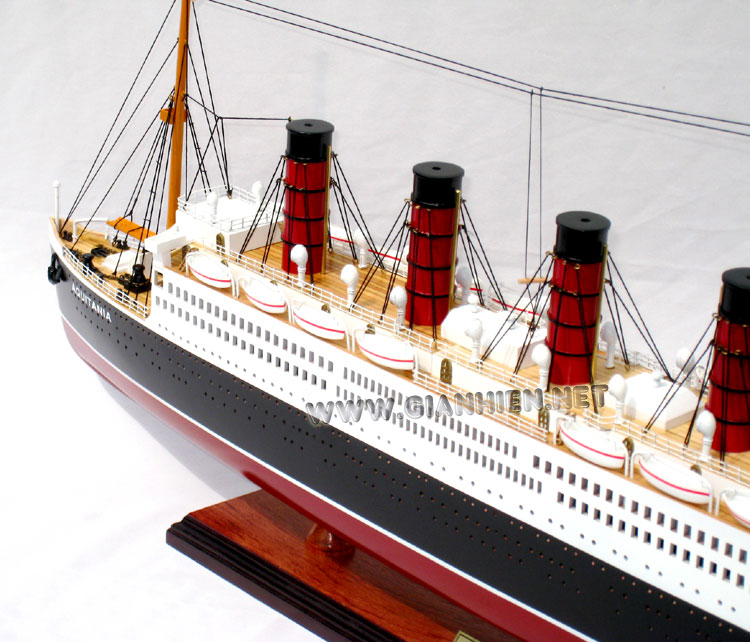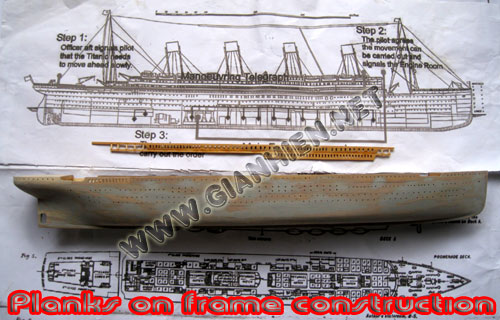|
RMS AQUITANIA
History in brief
RMS
Aquitania was a Cunard Line ocean liner that was built by
the John Brown and Company shipyard near Clydebank,
Scotland. She was launched on 21 April 1913 and sailed on
her maiden voyage to New York on 30 May 1914. Aquitania was
the third in Cunard Line's "grand trio" of express liners,
preceded by the RMS Mauretania and RMS Lusitania. Widely
considered one of the most attractive ships of her time,
Aquitania earned the nickname "Ship Beautiful". This despite
criticism of her looks; having too many cowl ventilators and
the forward funnel being as close to her bridge as it was.
In her 36 years of service, Aquitania survived military duty
in both world wars and was returned to passenger service
after each war. Aquitania's record for the longest service
career of any 20th century express liner stood until 2004,
when the Queen Elizabeth 2 (ultimate career service of 40
years) became the longest-serving liner.
Overview
The origins of Aquitania lay in the rivalry between the
White Star Line and Cunard, Britain's two leading shipping
companies. White Star's Olympic and Titanic were larger than
the latest Cunard ships Mauretania and Lusitania by 15,000
gross tons. The Cunard duo were significantly faster than
the White Star ships, while White Star's ships were seen as
more luxurious. Cunard needed another liner for its weekly
transatlantic express service, and elected to go with a
larger, slower, but more luxurious ship. But because
Aquitania's dimensions and appointments so closely resembled
or superseded the Olympic class ships, she was later
referred to as a "White Star Cunarder".
Design, construction and launch
The Aquitania was designed by veteran Cunard naval architect
Leon Peskett. Peskett drew up plans for larger and wider
vessel than his two previous large Cunard ships Lusitania
and Mauretania. With her four large smokestacks she would
resemble the famous speed duo but also Peskett designed her
superstructure with "glassed in" touches from the smaller
Carmania, a ship he also designed. Another design feature
from Carmania was the addition of two tall forward deck
ventilator cowlings. With Aquitania's keel being laid down
at the end of 1910, the experienced Peskett took a voyage on
the rival new Olympic in 1911 so as to experience the feel
of a ship reaching nearly 50,000 tonnes as well as to copy
pointers for his company's new vessel. Though the Aquitania
was built solely with Cunard funds, Peskett nevertheless
designed her to strict Admiralty specifications "just in
case of a war". Aquitania was built in the John Brown and
Company yards in Clydebank, Scotland, where the majority of
the Cunard ships were built. Her keel was laid in the same
plot that had famously served building Lusitania and that
would later be used for building Queen Mary, Queen Elizabeth
& the QE2. In the wake of the Titanic disaster, Aquitania
was one of the first ships to carry enough lifeboats for all
passengers and crew. Two of these lifeboats were motorised
launches with Marconi wireless equipment. As required by the
British Admiralty, she was designed to be convertible into
an armed merchant cruiser, and was reinforced to mount guns
for service in that role. Aquitania was launched on 21 April
1913 after being christened by Alice Stanley, the Countess
of Derby, and fitted out over the next thirteen months. In
May 1914 she was tested in her sea trials and steamed at a
full knot over the expected speed.
Interior and design
Although the Aquitania lacked the lean, yacht-like
appearance of her running mates - the Mauretania and
Lusitania - her greater length and wider beam allowed for
grander and more spacious public rooms. Her public spaces
were designed by the British architect Arthur Joseph Davis
of the interior decorating firm Mewès and Davis. This firm
had overseen the construction and decoration of the Ritz
Hotel in London and Davis himself had designed several banks
in the capital. His partner in the firm, Charles Mewès, had
designed the interiors of the Paris Ritz and had been
commissioned by Albert Ballin, head of Germany's Hamburg-Amerika
Line (HAPAG), to decorate the interiors of the company's new
liner, the Amerika. In the years prior to the First World
War, Mewès was charged with the decoration of HAPAG's trio
of giant new ships, the Imperator, Vaterland and Bismark,
while Davis was awarded the contract for the Aquitania. In a
curious arrangement between the rival Cunard and Hamburg-Amerika
Lines, Mewès and Davis would work apart - in Germany and
England respectively and exclusively - with neither partner
being able to disclose details of his work to the other.
Although this arrangement was almost certainly violated, the
interiors of the Aquitania were largely the work of Davis.
The Louis XVI dining saloon owed much to Mewès' work on the
HAPAG liners, but it is likely that having worked so closely
together for many years the two designers' work had become
almost interchangeable. Indeed, Davis must be given credit
for the magnificent Carolean smoking room and the fautless
Palladian lounge; a faithful interpretation in the style of
the architect John Webb.
Career
30 May 1914 saw the Aquitania sail on her maiden voyage
under the command of Captain William Turner. This momentous
event was however overshadowed by the sinking of the RMS
Empress of Ireland in Quebec the previous day on 29 May with
over a thousand drowned. The following month the Archduke
Franz Ferdinand of Austria was assassinated and the world
was plunged into World War I, interrupting Aquitania's
civilian career. After only three round trips she was taken
over for military use. At first she was converted into an
armed merchant cruiser, for which provision had been made in
her design. However, the Admiralty found that large liners
were too fragile and profilgate in their use of fuel to
serve as cruisers, so Aquitania did not serve long in that
role. After being idle for a time, in the spring of 1915 she
was converted into a trooper, and made voyages to the
Dardanelles. She then was converted into a hospital ship,
and served in that role in the Dardanelles campaign. In
1916, she was returned to the trooping front, and then in
1917 was again laid up. In 1918, she was back on the high
seas in troopship service, conveying North American troops
to Britain. Many of these departures were from the port of
Halifax, Nova Scotia where her spectacular dazzle paint
scheme was captured by artists and photographers, namely
Antonio Jacobsen. On one occasion she transported over 8,000
men.
In June 1919, she ran a Cunard "austerity service" between
Southampton and New York. In December of that year Aquitania
was docked at the Armstrong Whitworth yards in Newcastle to
be refitted for post-war service. She was converted from
coal burner to oil-fired, which greatly reduced the number
of crew needed in her engine room. (One crew member was
killed in an explosion in her engine room as she was being
converted to oil firing at the Armstrong Whitworth yard) Her
original fittings and art pieces were brought out of storage
and reinstalled.
During the 1920s Aquitania became one of the most popular
liners on the North Atlantic route. She sailed with the
Cunarders Mauretania and Berengaria in a trio known as "The
Big Three." As times grew better, Aquitania grew into the
role of being one of the most profitable ocean liners ever.
The American restriction on immigration in the early
Twenties ended the age of mass emigration from Europe, but
as ocean travel was the only means of transportation between
the continents, the ocean liners survived and even surpassed
old records. Some of the big money now came in from movie
stars and royalty, other aristocracy and politicians.
Aquitania became their favorite, as the 1920s became one of
the most profitable ages in ocean travel history.
However following the stock market crash of 1929 many ships
were affected by the devastating consequences. Aquitania
found herself in a tough position. Only a few could afford
expensive passage on her now, so Cunard used Aquitania to
provide cheap cruises to the Mediterranean. These were
successful, especially for Americans who went on "booze
cruises," tired of their country's prohibition. On 10 April
1935 Aquitania went hard aground near Thorne Knoll on the
River Test outside Southampton, England but with the aid of
ten tug boats and the next high tide she was freed
World War II
As time went on Aquitania grew older and was scheduled to be
replaced by RMS Queen Elizabeth in 1940. This plan was
shattered with the coming of World War II. In 1940 Aquitania
was in New York awaiting further orders. For a time she was
tied up alongside RMS Queen Mary, RMS Queen Elizabeth and
the Normandie and the four ships made an impressive sight
amongst large liners. Shortly after Aquitania sailed for
Sydney, Australia, in her Cunard colours, to become a troop
transport. Aquitania served valiantly as a troop transport,
just as she had in World War I. Later in 1940 Aquitania,
Queen Mary, Queen Elizabeth, SS Ile de France and other
ships sailed in a magnificent convoy out of Sydney,
Australia. In November 1941 Aquitania was in Singapore (then
still a British colony) getting a drabbish grey paint job
and later set sail to take part indirectly in the loss of
the Australian cruiser HMAS Sydney. The Sydney had engaged
in battle with the German auxiliary cruiser Kormoran. There
has been much unsubstantiated speculation that Kormoran was
expecting Aquitania, after spies in Singapore had notified
Kormoran's crew of the liner's sailing, and planned to
ambush her in the Indian Ocean west of Perth but instead
encountered Sydney on 19 November. Both ships were lost
after a fierce battle and a short time later Aquitania
arrived on the scene to pick up survivors of the German
ship, the captain going against orders not-to-stop for
survivors of sinkings. There were no survivors from the
Sydney. In her eight years of further military work,
Aquitania sailed more than 500,000 miles, and carried nearly
400,000 soldiers, to and from places as far afield as New
Zealand, Australia, the South Pacific, Greece and the Indian
Ocean.
Fate
After completing troopship service, she was handed back to
Cunard in 1946, who used her to transport war brides and
their children to Canada under charter from the Canadian
government. This final service created a special fondness
for Aquitania in Halifax, Nova Scotia, the port of
disembarkation for these immigration voyages. On completion
of that task in December 1949, she was taken out of service
when her Board of Trade certificate was not renewed as the
condition of the ship had reached a stage where she was too
old to be economical and brought in to line with safety
standards of the day. Also in 1949, a piano fell through the
roof of one of the dining rooms during a corporate board
meeting being held on the ship. This truly signaled the end
of Aquitania's operational life. The vessel was retired and
scrapped in 1950 in Scotland, thus ending an illustrious
career which included steaming 3 million miles in 450
voyages. Aquitania carried 1.2 million passengers over a
career that spanned nearly 36 years, making her the longest
serving Express Liner of the 20th Century. She was the only
major liner to serve in both World Wars, and she was
scrapped as the last four funneled passenger ship. Her wheel
and a fine half model of Aquitania may be seen in the Cunard
exhibit at the Maritime Museum of the Atlantic in Halifax.
|














